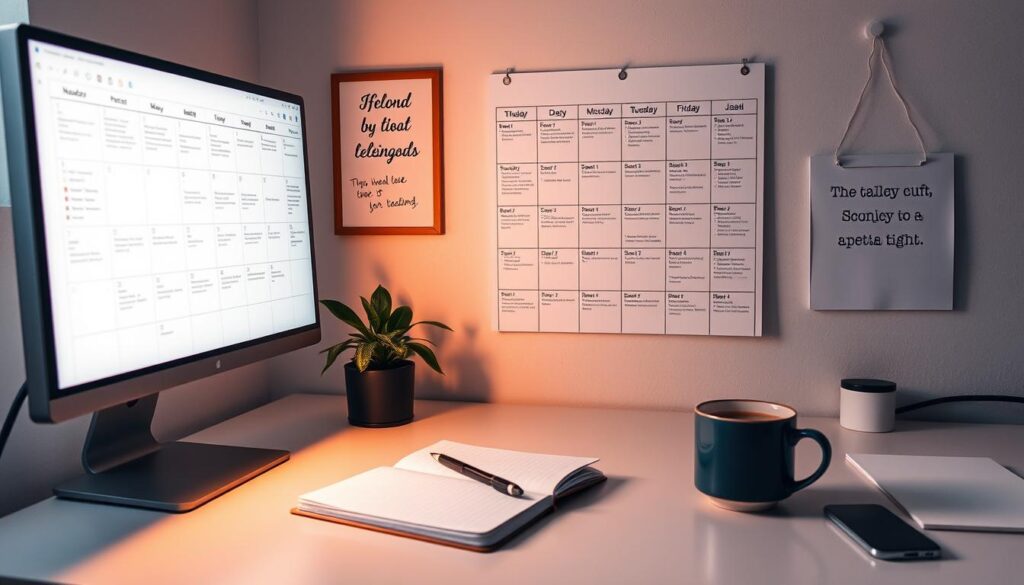“We are what we repeatedly do. Excellence, then, is not an act, but a habit.” – Aristotle’s timeless words underscore a truth embraced by leaders like Bill Gates and Michelle Obama: small, intentional actions compound into extraordinary results. Whether it’s waking up early to prioritize critical tasks or carving out moments for reflection, how you structure your day directly influences your trajectory.
Consider Jeff Bezos’ commitment to eight hours of sleep or Tim Ferriss’ strategy of limiting email checks. These aren’t random quirks—they’re deliberate practices designed to optimize focus and reduce stress. Research shows that even simple acts, like making your bed or writing down three gratitudes, can sharpen mindset and fuel productivity.
What separates high achievers isn’t innate talent—it’s their approach to time. They treat minutes as non-renewable currency, investing in routines that align with long-term goals. From mindfulness exercises to strategic planning, these habits create a framework for sustained growth. This isn’t about rigid schedules; it’s about designing a rhythm that works for you.
Key Takeaways
- Intentional routines reduce stress and amplify productivity, even for top performers.
- Time management strategies—like prioritizing three daily tasks—prevent burnout.
- Mindfulness practices, such as meditation, enhance emotional resilience.
- Real-world examples from leaders provide actionable blueprints for improvement.
- Everyday moments offer opportunities to build momentum toward larger objectives.
Understanding the Power of Daily Success Habits
What separates ordinary days from extraordinary results? Cooper Harris, founder of Klickly, puts it bluntly: “Rituals don’t restrict freedom—they create the mental space needed for breakthroughs.” Small, intentional behaviors act as levers, amplifying progress in both professional work and personal life.

How Small Actions Shape Big Outcomes
Targeted routines rewire neural pathways over time. Syed Balkhi, CEO of WPBeginner, attributes his company’s growth to a 15-minute planning ritual each morning. This habit conserves mental energy—like a cognitive shortcut for decision-making.
Consider how LinkedIn’s Jeff Weiner schedules buffer time between meetings. This practice reduces stress while improving strategic thinking. Similarly, Oprah Winfrey’s gratitude journaling demonstrates how simple acts enhance emotional resilience.
The Rhythm of Lasting Achievement
Consistency transforms isolated efforts into life-changing patterns. Research reveals that people with structured morning routines report 23% higher productivity levels. They’re not just managing time—they’re cultivating a mindset primed for growth.
Physical health benefits emerge too. Richard Branson’s sunrise tennis sessions boost both energy and creativity. These examples show how deliberate habits form an ecosystem where professional work thrives alongside personal well-being.
When actions align with purpose, every choice becomes a stepping stone. The key lies not in perfection, but in designing rhythms that sustain momentum through life’s inevitable challenges.
Morning Routines: Kickstart Your Day with Purpose
How you begin your morning often dictates the rhythm of your entire day. Take Tonika Bruce, CEO of Lead Nicely, who starts with 10 minutes of journaling to clarify priorities. This practice mirrors Salvador Ordorica’s approach—combining hydration and movement to activate both body and mind.

Designing a Consistent Morning Routine
Start small: 86% of high performers dedicate the first hour to self-care. Begin with a full glass of water—hydration jumpstarts metabolism. Next, write three goals. This 5-minute task builds direction without overwhelm.
Avoid screens for 30 minutes post-wakeup. Instead, try stretching or reading. Consistency matters more than duration—even 7 minutes of yoga creates muscle memory over time.
Incorporating Movement, Meditation, and Mindfulness
Physical activity isn’t optional. LinkedIn’s Jeff Weiner does 20-minute walks; you might prefer planks or sun salutations. Movement oxygenates the body, sharpening mental clarity.
Follow with breathwork: inhale for 4 counts, hold for 7, exhale for 8. This Navy SEAL-tested method reduces stress hormones. Pair it with gratitude reflections—name one thing you appreciate while brewing coffee.
These micro-practices compound. As Bruce notes: “Your morning isn’t about perfection—it’s about claiming agency before the world demands your attention.”
Strategic Planning and Time Management for Success
What if you could turn chaotic workdays into predictable progress? Jared Atchison, co-founder of WPForms, argues: “Time management isn’t about squeezing more into your day—it’s about creating space for what moves the needle.” This mindset shift separates reactive scrambling from intentional achievement.

Prioritizing Tasks and the Benefits of Time Blocking
Start by categorizing work using the Eisenhower Matrix. Urgent vs. important distinctions reveal which things demand immediate attention—and which can wait. John Turner of SeedProd schedules “focus blocks” for high-impact tasks, shielding them from meetings or emails.
Time blocking works because it:
- Reduces decision fatigue through pre-planned segments
- Creates visual accountability for your job priorities
- Minimizes context-switching that drains mental energy
Creating To-Do Lists for Focused Productivity
Effective lists follow the “3-3-3 method”: three critical tasks, three medium priorities, and three quick wins. This way of organizing ensures you tackle mission-critical things first. Digital tools like Todoist let you tag items by project—but pen-and-paper works too.
Atchison recommends reviewing your list nightly: “Crossing off completed items isn’t just satisfying—it trains your brain to associate planning with progress.” Pair this with weekly calendar audits to eliminate low-value activities.
When you align time investments with goals, productivity becomes sustainable. It’s not about doing more—it’s about doing what matters in smarter ways.
Healthy Body and Mind: Nutrition, Sleep, and Exercise
Your physical well-being acts as the foundation for everything else. Studies show that 44% of professionals with poor sleep quality struggle to maintain focus during important tasks—a gap that impacts decision-making and creativity. “You can’t outwork a bad diet or sleep deprivation,” notes Thomas Griffin, co-founder of OptinMonster. This truth drives high performers to treat their bodies like precision instruments.
Healthy Eating, Hydration, and Vital Nutrition Tips
Stephanie Wells, founder of ThrivSEO, starts her day with a protein-rich breakfast—a practice linked to 12% higher cognitive performance. Her strategy aligns with research showing balanced meals stabilize energy better than quick snacks. For those juggling busy schedules, strategic nutrition planning proves essential:
- Pre-chop veggies for grab-and-go meals
- Set phone reminders to drink water hourly
- Replace sugary drinks with herbal teas or infused water
The Role of Sleep and Physical Activity in Daily Success
Successful people guard their sleep like CEOs protect profit margins. While 7-9 hours is ideal, consistency matters most. Fitness expert Jillian Michaels pairs morning workouts with sunlight exposure—a dual boost for vitamin D and circadian rhythm regulation.
Even small movements add up. A 10-minute walk after meals aids digestion and clears mental fog. As Griffin advises: “Treat exercise as non-negotiable as client meetings. Your body funds every achievement.”
Enhancing Creativity and Continuous Learning
In industries evolving at lightning speed, stagnation is the real career risk. Rong Zhang, a learning strategist, notes: “Knowledge isn’t static—it’s the currency of adaptability.” The World Economic Forum predicts 50% of workers will need reskilling by 2025. This makes ongoing education not just beneficial—it’s essential for relevance.
Building Knowledge Through Reading and Updates
Top performers treat books as tools for mental expansion. Bill Gates reads 50 books yearly, while Oprah Winfrey credits her book club with sharpening critical thinking. Start with 15-minute daily reading sessions—research shows this habit boosts retention by 27% compared to sporadic bursts.
Pair reading with curated newsletters like Maria Popova’s Brain Pickings. These resources distill complex ideas into actionable insights. To stay consistent:
- Place books in high-traffic areas (coffee tables, nightstands)
- Use apps like Blinkist for summaries during commutes
- Join virtual book clubs for accountability
Leveraging Audio Learning and Expert Insights
Podcasts turn downtime into growth opportunities. Safari Books Online’s daily challenges help professionals absorb concepts in 20-minute intervals. For deeper dives, follow thought leaders like Brené Brown or Adam Grant—their frameworks spark innovative problem-solving.
Microsoft’s Satya Nadella schedules “learning hours” weekly. Mirror this approach:
- Replace background music with industry podcasts during workouts
- Bookmark 2-3 TED Talks monthly for inspiration
- Use apps like getAbstract to track progress toward learning goals
As Zhang emphasizes: “Curiosity isn’t a trait—it’s a practiced skill.” By weaving knowledge acquisition into existing routines, you create a self-reinforcing cycle of growth and creativity.
Building Relationships and Networking for Growth
Behind every career leap lies a network of trusted allies. Sheryl Sandberg once noted: “Leadership is about making others better as a result of your presence—and ensuring that impact lasts in your absence.” Relationships act as both safety nets and springboards, offering support during challenges and unlocking doors to new opportunities.
Maintaining Key Personal and Professional Relationships
Strong connections thrive on mutual value. Instead of transactional check-ins, share resources tailored to others’ goals—like forwarding a relevant article or introducing complementary contacts. Reid Hoffman, LinkedIn co-founder, schedules monthly coffee meetings to deepen ties without overwhelming his calendar.
Balance networking with work tasks by anchoring it to existing routines. For example, review contacts while commuting or set a weekly reminder to congratulate someone’s achievement. These micro-actions build trust over time—like watering plants rather than flooding them.
Quality trumps quantity. Attend one industry event quarterly, but prepare three open-ended questions to spark meaningful dialogue. As entrepreneur Bozoma Saint John advises: “Focus on listening more than pitching—you’ll uncover needs you can actually address.”
Strategic relationship-building creates ripple effects. A tech executive recently credited 80% of her promotions to mentorships formed during early-career volunteer work. By investing in others consistently, you lay the foundation for unexpected collaborations and career-defining moments.
Daily Success Habits: Transforming Work and Personal Life
Transforming both career and personal life starts with bridging intention with action. Leaders like Melinda Gates and Satya Nadella don’t separate professional rigor from personal growth—they design routines that feed both. The key lies in practice, not perfection, and recognizing that how you approach habits determines their staying power.
Actionable Steps to Integrate Daily Habits
Begin by anchoring new behaviors to existing ones. A marketing executive doubled her water intake by pairing hydration with her morning email review—a simple act that improved energy and mood. Similarly, pairing gratitude reflections with coffee breaks creates moments of mindfulness without overhauling schedules.
Mistakes aren’t failures—they’re feedback loops. When a startup founder missed three consecutive workout days, she analyzed triggers rather than quitting. This shift turned setbacks into data points for refining her routine. As resilience-building practices show, progress thrives when we treat slip-ups as course corrections.
The Long-Term Impact of Consistent Success Practices
Over time, small actions rewire brains and environments. A study of 500 professionals found those journaling gratitude daily reported 19% stronger relationships with friends and colleagues. Their positivity created a ripple effect—teams became 14% more collaborative within six months.
Consistency builds antifragility. An entrepreneur who meditated for 90 seconds daily during commutes gradually increased to 10 minutes, enhancing focus during high-stakes negotiations. Like compound interest, these efforts accumulate into unshakable foundations for growth.
Practical Tips from Successful People and Influencers
Industry leaders often credit their achievements not to grand gestures, but to business-optimized routines refined through trial and error. Jeff Bullas, a digital entrepreneur with 20M+ blog visitors, attributes his productivity to 90-minute “deep work” blocks paired with midday walks. This balance reduces stress while fueling creativity—a formula replicated by executives at companies like Asana and Shopify.
Insights from Entrepreneurs and Leading Professionals
Bullas’ approach mirrors strategies from other high performers. He schedules content creation during peak energy hours (7-9 AM) and reserves afternoons for collaborative work. “Time blocking isn’t about rigidity—it’s about respecting your cognitive limits,” he explains. Similarly, productivity coach Breanne Dyck advises clients to automate repetitive tasks, freeing 6-8 weekly hours for strategic thinking.
Mentorship emerges as a common thread. A tech CEO increased revenue by 40% after adopting her advisor’s “three-question nightly review”: What worked? What didn’t? What’s one opportunity for tomorrow? This practice builds accountability while identifying growth levers.
Real-World Examples and Common Pitfalls to Avoid
Contrast two approaches: A founder who checks emails hourly experiences 27% higher cortisol levels than one using scheduled batches. The NAB Bank study reveals 68% of professionals initially overcomplicate routines—like six-hour Sunday planning sessions that breed resentment.
Key missteps include:
- Prioritizing quantity over quality (e.g., ten daily tasks vs. three high-impact goals)
- Ignoring energy cycles (scheduling analytical work post-lunch when focus dips)
- Neglecting recovery (92% of burned-out leaders skipped leisure activities)
Those who sustain progress leverage ways to adapt. A marketing director replaced rigid hour-long meditations with 5-minute breathwork breaks between meetings—a shift that improved team morale by 18%. As Bullas notes: “Sustainable routines evolve with your business needs and personal bandwidth.”
Consistency in these practices unlocks future opportunities. One agency owner gained keynote speaking invites after sharing her habit-tracking framework online—proof that small, shared improvements create ripples beyond immediate results.
Conclusion
The journey toward lasting achievement begins with recognizing the cumulative power of intentional actions. Each practice discussed—from strategic time blocking to prioritizing energy-boosting nutrition—builds resilience in a fast-paced world. Whether dedicating morning hours to focused work or carving space for books that spark innovation, these behaviors compound into transformative results.
True growth emerges from consistency, not grand overhauls. Start by aligning small choices with long-term goals: a five-minute planning session instead of scrolling, or swapping sugary snacks for brain-fueling alternatives. Research confirms that nearly 40% of daily actions stem from ingrained patterns—proof that incremental shifts reshape trajectories.
Embrace this process as an evolving practice. Like refining a skill, habit formation thrives on adaptability. Track what drains or renews your energy, then adjust routines accordingly. Leaders like James Clear emphasize “atomic” changes—tiny adjustments that yield outsized impacts over weeks and months.
Your world expands when you treat time as fertile ground for progress. Replace “someday” thinking with today’s intentional choices. Whether optimizing work hours or discovering insights through books, every step forward lays bricks for the life you envision. Start now—not perfectly, but persistently—and watch small efforts bloom into extraordinary outcomes.
FAQ
How do morning routines improve productivity?
Structured mornings prime the brain for focus by reducing decision fatigue. Activities like exercise or meditation activate neural pathways linked to clarity, while planning tasks aligns priorities. This creates momentum, helping professionals tackle high-impact work first.
What’s the fastest way to prioritize tasks effectively?
Use the Eisenhower Matrix—categorize tasks by urgency and importance. Pair this with time blocking to dedicate specific hours to deep work. Apps like Todoist or Trello help visualize priorities, minimizing distractions from low-value activities.
Why is hydration linked to better decision-making?
Even mild dehydration reduces cognitive performance by 15%. Water supports neurotransmitter function and nutrient delivery to the brain. Carry a reusable bottle and set hourly reminders to maintain energy levels and mental sharpness.
Can podcasts replace reading for professional growth?
Both serve unique roles. Podcasts like The Tim Ferriss Show offer actionable insights during commutes, while books provide depth. Aim for 20 minutes of reading daily and supplement with podcasts to stay updated on industry trends.
How do successful people avoid burnout?
They enforce boundaries—like Arianna Huffington’s “no phones at dinner” rule—and schedule recovery time. Regular exercise, 7-9 hours of sleep, and mindfulness practices reset the nervous system, sustaining long-term performance.
What’s a common mistake when building new habits?
Overcompliance. Starting with 10-minute workouts or two-page reading sessions builds consistency without overwhelm. Apps like Habitica gamify progress, reinforcing small wins that compound over weeks.
How does networking boost career success?
Relationships create opportunities—85% of jobs come through connections. Schedule weekly check-ins with mentors or peers using tools like Calendly. Authentic conversations foster trust, opening doors to collaborations or promotions.
Why do top performers track their habits?
Measurement drives accountability. Journals or apps like Streaks highlight patterns—like skipped workouts correlating with lower focus. Adjust routines based on data to optimize energy and output.
Can exercise replace caffeine for energy boosts?
Short bursts of activity increase alertness by 21%—outperforming coffee’s 12%. A 7-minute HIIT session triggers endorphin release, enhancing mood and concentration without caffeine crashes.
How long until new habits feel automatic?
Research shows 66 days on average. Pair habits with existing triggers—like meditating after brushing teeth—to accelerate adoption. Celebrate 10-day milestones to stay motivated during the transition.




























































